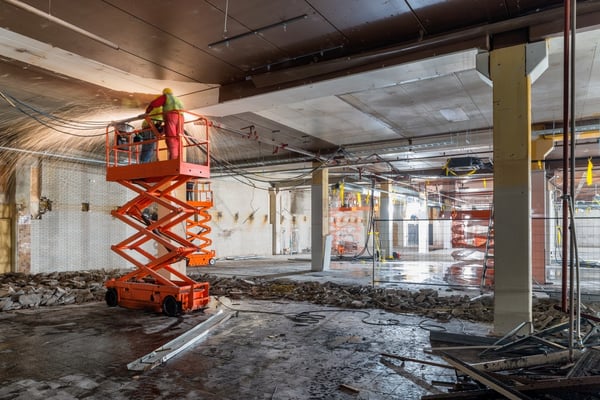It’s common for construction projects to have work that needs to be done at height - this can include anything from ceiling repair to shifting materials in a warehouse. If it’s a task that requires more than just a ladder, the scissor lift is one of the safest ways to work at height. Their sturdy platform and railings provide a safe and secure place for workers to complete jobs and for inventory or materials to be moved.
Hire a scissor lift safely
Although scissor lifts are safe and convenient, there are always risks when working on a job at height. Whilst there are laws in all Australian states and territories to protect people against the risk of injury, accidents can still occur. After evaluating previous incidents, Workplace Health and Safety found that the more serious injuries fell into three categories: positioning, stabilisation, and fall protection.
Keep reading to find out our top 5 tips for scissor lift safety!
1. Job Requirements
Determining what work needs to be completed with the scissor lift is the first step to carrying out work safely. Before you start work, the key things to know about your job should include:
- What type of work is being completed
- Where is the job located (including site and environment)
- Whether there are any approvals required
- The height of the job
- The expected outcomes of the task
2. Basic safety checks
Before you or anyone else starts working on or operating the scissor lift, there are some basic safety checks that need to be done beforehand.
Training
Have all workers received scissor lift training? Project managers should know if all personnel working with or near a scissor lift have had the appropriate training and understand the risks involved with the machinery. Briefing workers on the job’s requirements and safety needs is a great way to make sure everyone is aware of the hazards involved.
Environment
Make sure the areas surrounding the scissor lift are clear is essential to avoid any unwanted collisions. If the scissor lift is being used in a warehouse, make sure all floor workers are aware of the machine's path and understand that materials are being moved at height. If the work is being completed outside, make sure the terrain is stable, there are no nearby power lines and all workers are aware of the job happening on their site.
Maintenance and protective controls
Checking that the machinery is safe to operate before use is vital. No matter how cautious you are when operating a scissor lift, it is essential to create a safe environment for equipment use. Making sure the scissor lift has been fully serviced and maintained is critical when thinking about the safety of everyone on site. Testing the brakes, alarm functions and rail stability of the scissor lift should happen before every use.

3. How to stabilise a scissor lift
One of the most common causes of preventable scissor lift accidents is poor machine stabilisation. If not properly stabilised or secured, the scissor lift can tip over and potentially cause damage and injuries to workers, other equipment or materials.
Here are a few general rules to make sure your scissor lift never tips over:
- Before moving the machine, always lower the work platform and clear the surrounding environment of any obstructions or workers
- Work in appropriate weather conditions - rain and strong winds are major causes of instability and can even cause the terrain to shift
- Always work on firm, level surfaces
4. How to safely position a scissor lift
Positioning your scissor lift correctly has a huge impact when preventing accidents. If the scissor lift is positioned incorrectly, all workers are at serious risk of life-threatening injuries. To prevent these types of accidents, always be sure that the surrounding area and path is clear of people when moving the machine. If the job is near a power source, make sure to always distance yourself and the scissor lift to prevent electrical damage. However, if the job requires work with electricity, make sure everyone working has had the appropriate electrical training.
5. How to protect yourself from falls on a scissor lift
Whilst Occupational Health and Safety don’t require you to work wearing a harness or other restraints, it doesn’t mean you shouldn’t. There are always going to be hazards associated when working at heights - and even though the guard rail is the scissor lifts greatest asset in preventing fall accidents - wearing a harness will prevent any serious fall injuries from occurring.
Even though there are plenty of safety measures when operating a scissor lift, understanding the risks and actively taking precautions to prevent them is one of the best ways to prevent serious accidents. If you are unsure which scissor lift is right for your project requirements, check out our blog on what scissor lift is right for your job. If you need a scissor lift for your next project, be sure to check out our scissor lift hire directory to find the best machine for your job!
Here at iseekplant, we have an extensive network of scissor lift suppliers covering Brisbane, Sydney, Melbourne, Canberra, Perth, Darwin, Adelaide, and everywhere in between. Get rates with us today to bring your project to life!
If you need a bit more information, read our scissor lift hire rates guide and make sure to subscribe to our Constructionsht Blog so you never miss a piece of industry insight.


